Federal Data Shows a Drop in Campus Cops — For Now
As DOJ issues scathing report on Uvalde police response, new federal data show police presence in schools dwindled after Black Lives Matter protests.
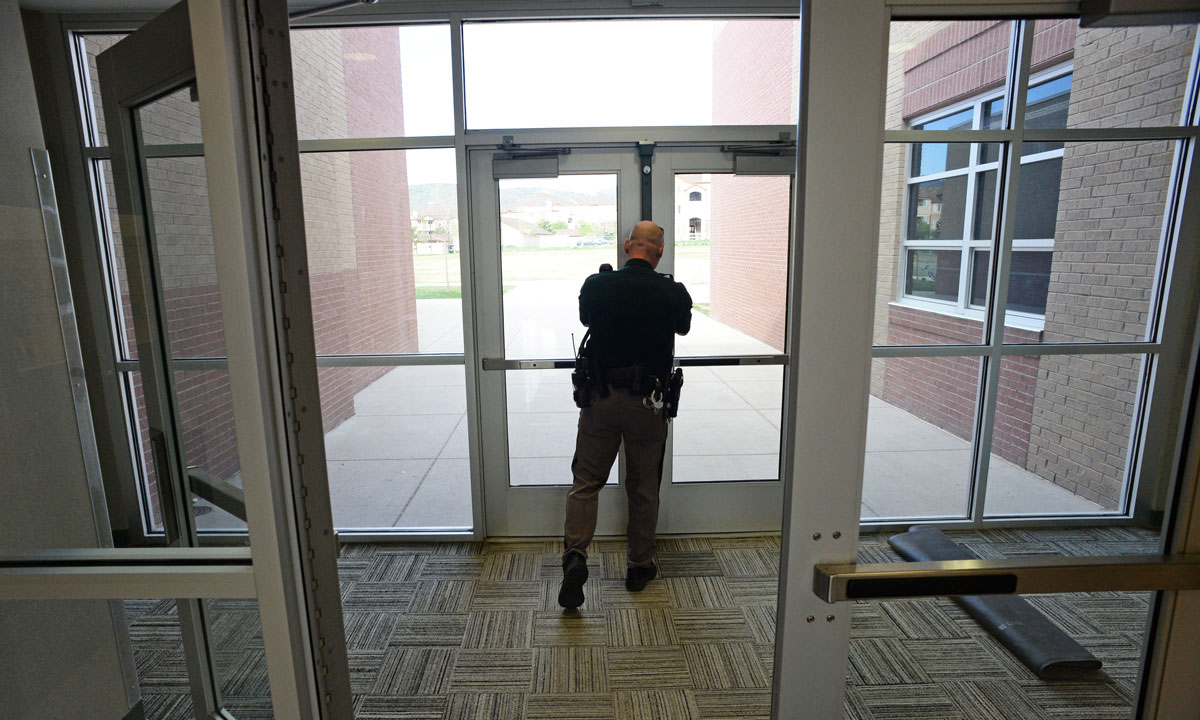
Get stories like these delivered straight to your inbox. Sign up for The 74 Newsletter
More than 1 in 10 schools with a regular police presence removed officers from their roles in the aftermath of George Floyd’s murder at the hands of a Minneapolis cop, new federal data on campus crime and safety suggest.
Nearly 44% of public K-12 schools were staffed with school resource officers at least once a week during the 2021-22 school year, according to a national survey released Wednesday by the Education Department’s National Center for Education Statistics. Between Floyd’s murder in May 2020 and June 2022, more than 50 school districts nationwide ended their school resource officer programs or cut their budgets following widespread Black Lives Matter protests and concerns that campus policing has detrimental effects on students — and Black youth in particular.
The data reflect an 11% decrease in school policing from the 2019-20 school year, when more than 49% of schools had a regular police presence, according to the nationally representative federal survey. That year, schools underwent an increase in campus policing after the 2018 mass school shootings in Parkland, Florida, and Santa Fe, Texas, prompted a surge in new security funding and mandates, a pattern that could repeat itself when future federal numbers capture the nation’s reaction to the 2022 school shooting in Uvalde, Texas.
“This is the George Floyd effect,” said criminal justice researcher Shawn Bushway, who pulled up a calculator during a telephone interview with The 74 and crunched the federal survey data against a tally of districts that removed cops from their buildings, which collectively served more than 1.7 million students.
“It’s not seismic, but I think what’s most interesting about it is that it’s the reversal of a trend in a fairly dramatic way,” said Bushway, a University at Albany in New York professor. “It’s been going up quite a bit and now it’s dropped.”
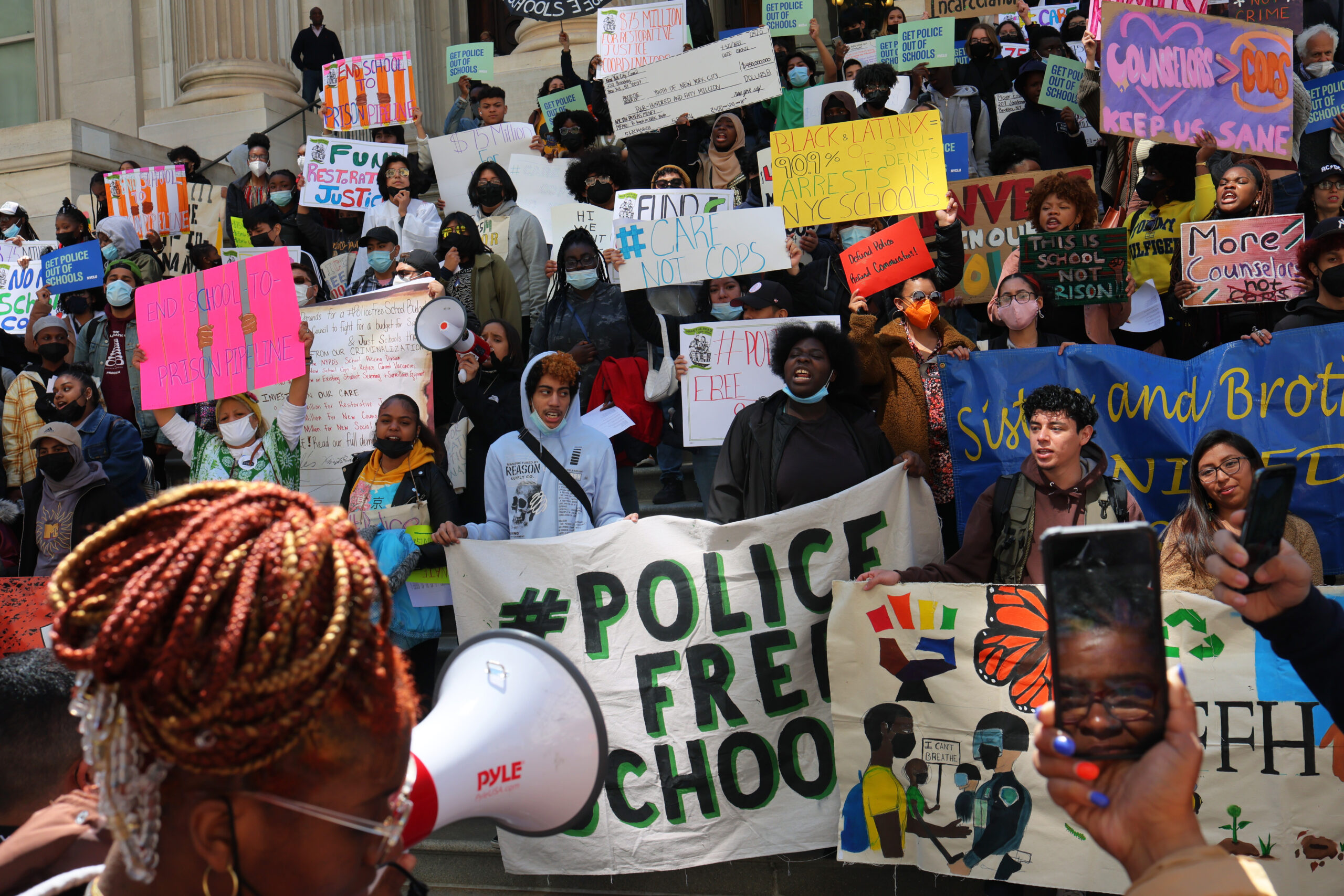
The new federal data were published the same week as Thursday’s release of a damning U.S. Department of Justice report that cited “critical failures” by police during the May 2022 mass shooting at Uvalde’s Robb Elementary School in which 19 students and two teachers were killed. During the shooting, 376 law enforcement officers responded to the scene but waited more than an hour to confront the 18-year-old shooter, a botched reaction that disregarded established police protocols and, investigators said, cost lives.
“Had law enforcement agencies followed generally accepted practices in an active shooter situation and gone right after the shooter to stop him, lives would have been saved and people would have survived,” U.S. Attorney General Merrick Garland said at a Thursday afternoon press conference in Uvalde.
“Their loved ones deserved better,” he said.
Chris Chapman, the associate commissioner of the National Center for Education Statistics, said on a press call Tuesday that the survey data didn’t make clear a definitive reason for the decline in school-based officers. Experts said that several other factors, including campus closures during the pandemic, budget constraints and a national police officer shortage, may have also contributed.
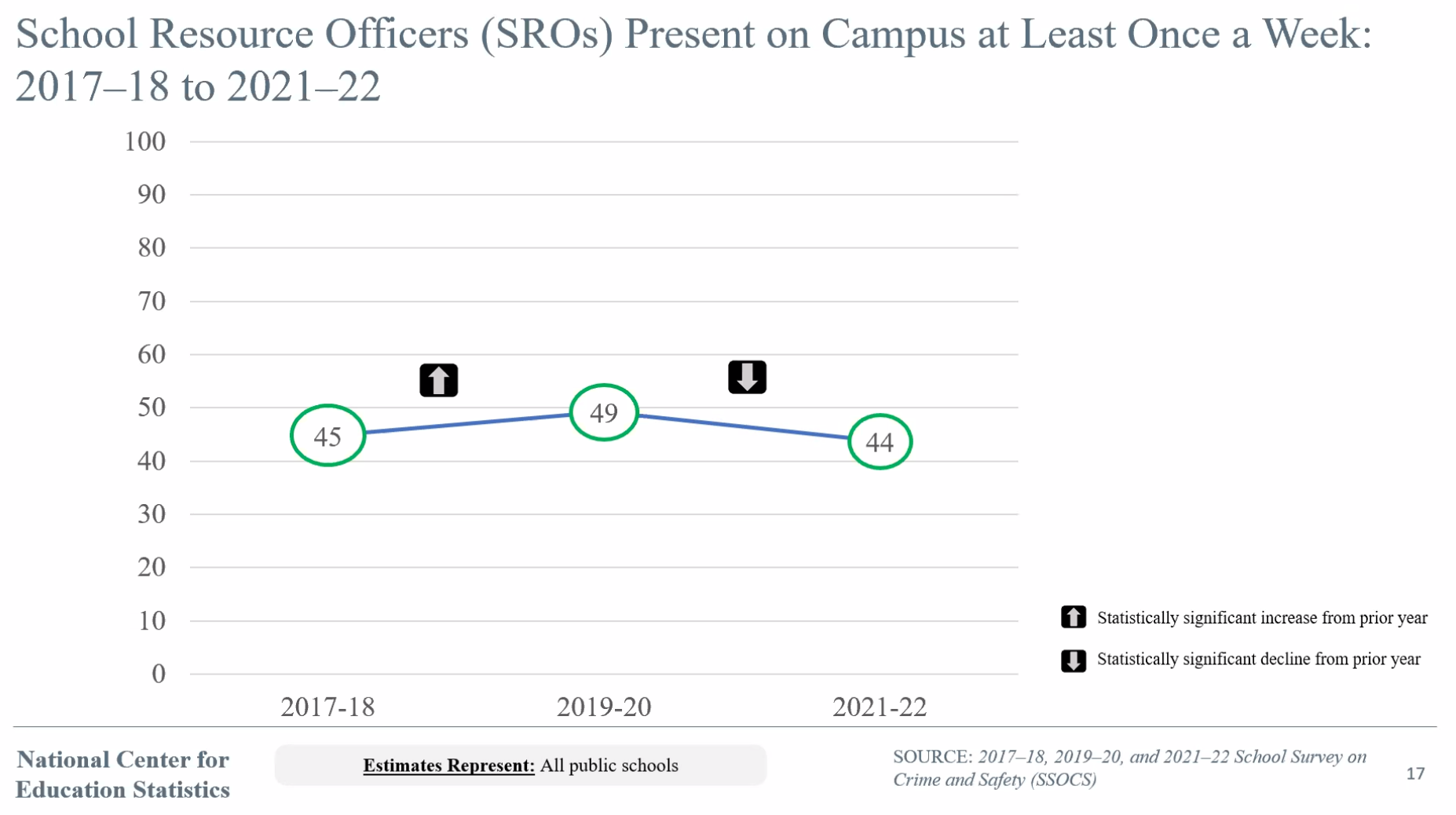
Either way, the downward trend may be short-lived.
Multiple districts that cut their school resource officer programs after Floyd’s murder, including those in Denver, Colorado, and Arlington, Virginia, reversed course after educators reported an uptick in classroom disorder after COVID-era remote learning. Mass school shootings have long driven efforts to bolster campus policing, a reality that has played out in the last several years as the nation experienced an unprecedented number of such attacks.
Despite officers’ grievously mishandled response in Uvalde, the shooting led to renewed efforts in Texas and elsewhere to strengthen police presence in schools. A similar situation played out after the mass shooting at Parkland’s Marjory Stoneman Douglas High School. Federal data show national growth in campus policing even after the school resource officer assigned to the Broward County campus failed to confront the gunman, who killed 17 people.

The now-former officer, Scot Peterson, was acquitted of criminal negligence and perjury charges but faces a new trial in a civil lawsuit by shooting victims’ families, who allege his failure to intervene during the six-minute attack displayed a “wanton and willful disregard” for students’ and teachers’ safety. Qualified immunity generally protects officers from liability for mistakes made on the job.
It’s not the way I want to gain business, but some of the busiest years we’ve had training wise are 18 months after a school massacre.
Mo Canady, executive director, National Association of School Resource Officers
After Parkland, a new Florida law required an armed security presence on every K-12 campus. The Uvalde shooting led to similar mandates in Texas and Kentucky. In both states, a police officer labor shortage, which experts said may have contributed to the 2021-22 decline in schools, has hindered officials’ efforts to comply. In Kentucky, more than 40% of schools lack school resource officers, a reality that school officials have blamed on a lack of funding and a depleted applicant pool.

“It wouldn’t surprise me if, when that data comes back out, we see that spike go back up,” said Mo Canady, executive director of the National Association of School Resource Officers, which offers a training program for campus cops. “It’s not the way I want to gain business, but some of the busiest years we’ve had training wise are 18 months after a school massacre. I can tell you that 2019 was the biggest year in our association’s history by far — and that’s coming right off the Marjory Stoneman Douglas massacre.”
Advocates for police-free schools recognize the headwinds they face. Tyler Whittenberg, the deputy director of the Advancement Project’s Opportunity to Learn initiative, said that while advocates “are proud of the victories that were won” after George Floyd’s murder, educators who removed police from schools “are fighting really hard to hold onto those gains,” some of which face state efforts to place police in districts that don’t want them.
“We’re not really rushing to a conclusion that this represents an overall reduction in police in schools, especially because for many of our partners on the ground this is not their day-to-day experience,” he said. “They’re having to fight back — especially at the state level — against efforts to increase the number of police in their schools.”
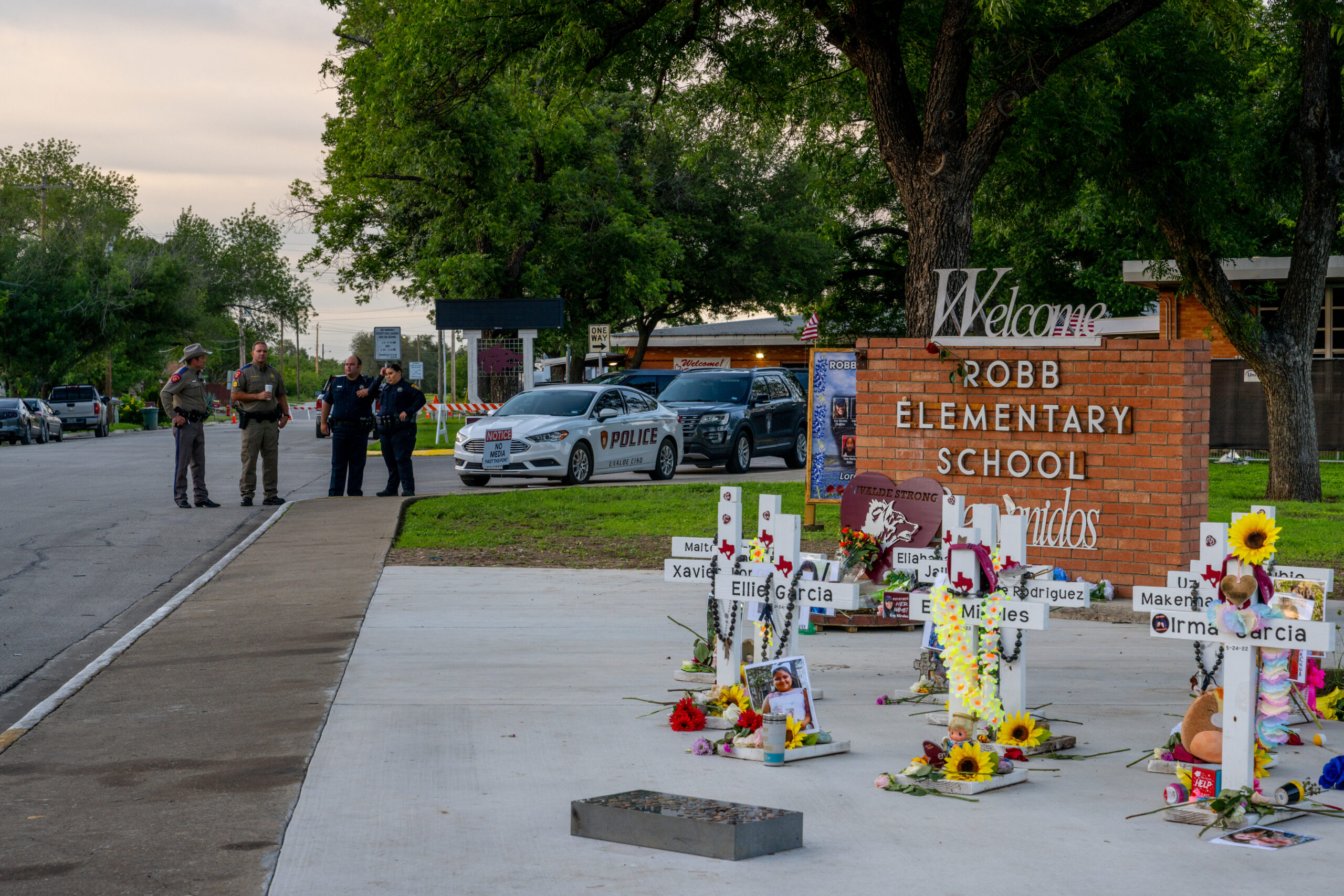
Safety threats on the decline
In the 1970s, just 1% of schools were staffed by police. Decades of efforts since then to swell their ranks have coincided with a marked improvement in campus safety.
During the 2021-22 school year, 67% of schools reported at least one violent crime on campus, totaling some 857,500 violent incidents. Federal data show the nation’s schools experienced a violent crime rate of 18 incidents per 1,000 students in 2021-22. That’s a steep decline from 1999-00, when schools recorded a violent crime rate of 32 incidents per 1,000, and 2009-10, when the violent crime rate was 25 per 1,000.
Police officers’ contributions to making schools safer over the past two decades, however, remain the subject of ongoing research and heated debate. In a study last year, which was published in the peer-reviewed Journal of Policy Analysis and Management, Bushway and his colleagues found that placing school resource officers on campuses led to a marginal decline in some forms of school violence. And although researchers were unable to analyze officers’ effects on mass school shootings because such tragedies are statistically rare, they were associated with an uptick in reported firearm offenses — suggesting an increased detection of guns. The officers were also associated with a stark uptick in student disciplinary actions, including suspensions and arrests, particularly among Black students and those with disabilities.
“There’s a cost-benefit here and everybody’s calculus on how you weigh these different things is going to be different,” Bushway said. “There’s no pure answer to that question, different people are going to answer that question differently.”
Previous research suggests that suspensions do not lead to improved student behaviors or improve school safety, but have detrimental effects on punished students’ academic performance, attendance and behavior. Their effects on non-misbehaving students remain unclear.
Other researchers have reached a much more critical conclusion about the effects of school-based police on students. In a meta-analysis published in November on the existing literature into school officers’ efficacy, researchers failed to identify evidence that school-based law enforcement promoted safety in schools but reinforced concerns that their presence “criminalizes students and schools.”
“I think the evidence is increasingly supporting the notion that police don’t belong in schools,” report author Ben Fisher, an associate professor of civil society and community studies at the University of Wisconsin-Madison, told The 74. Removing officers who have been there for years, he said, may cause problems of its own. “If we’re going to get police out of schools, which I think is the right long-term vision and short-term vision, I think we need to do it thoughtfully with plans in place to make schools welcoming and supportive.”
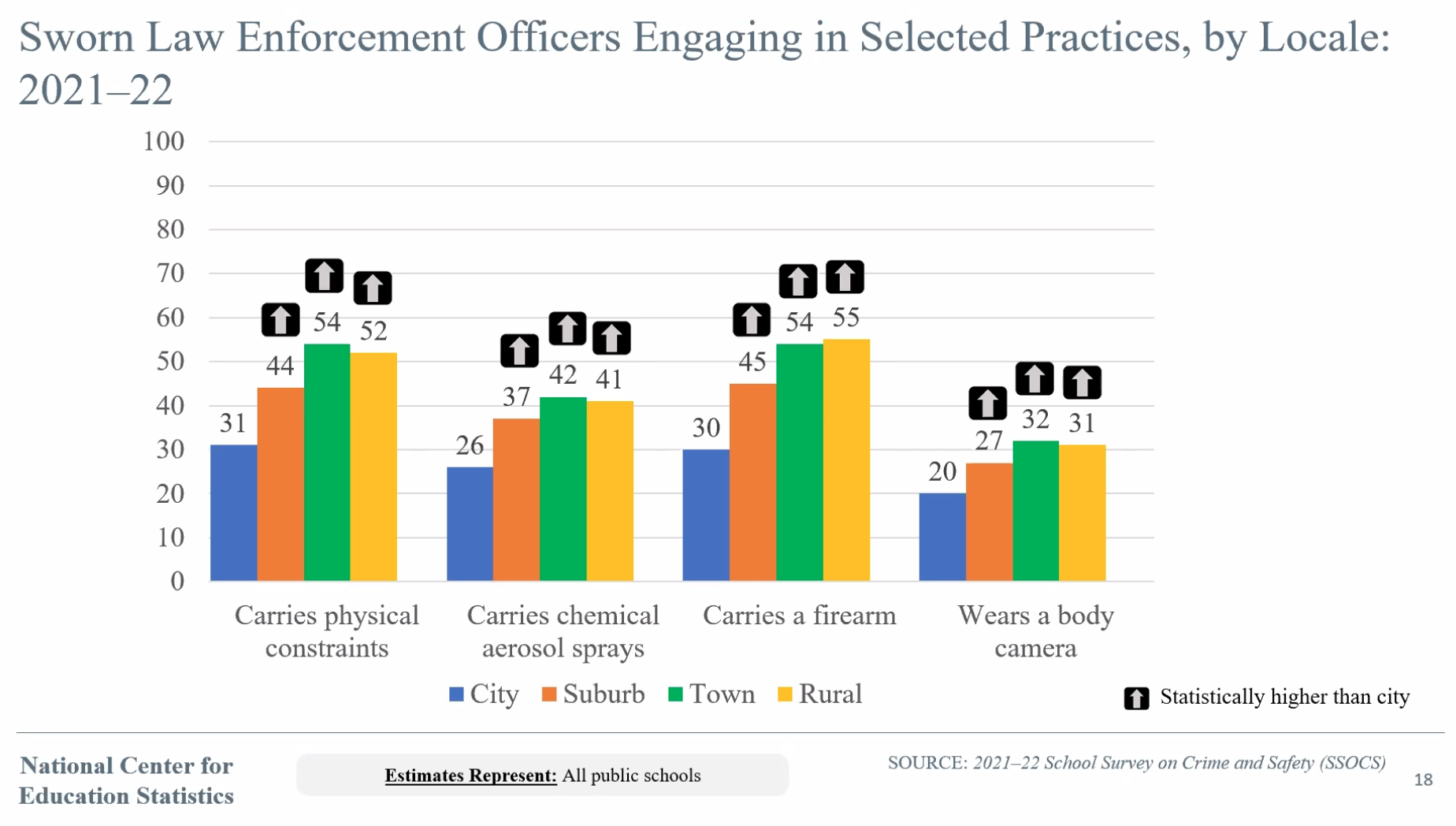
The federal survey, which was conducted between Feb. 15 and July 19, 2022, also found large geographical differences in the types of tools that school-based police use on the job. Across the board, officers in urban areas were less likely than their rural and suburban counterparts to carry guns and pepper spray or to be equipped with body-worn cameras.
Beyond data on campus policing, the new federal survey offers a comprehensive look at the state of campus safety and security, reflecting school leaders’ responses to the pandemic and record numbers of mass school shootings. Other findings include:
- In 2021-22, about 49% of schools provided diagnostic mental health assessments to evaluate students for mental health disorders. This is a decline from 2019-20, when 55% conducted assessments. Meanwhile, 38% provided students with treatments for mental health disorders in 2021-22, down from 42% in 2019-20.
- Restorative justice, a conflict resolution technique, was used in 59% of schools in 2021-22, which was similar to 2019-20 but an increase from the 42% that used the approach in 2017-18.
- The latest data indicate a decline in campus drug and alcohol incidents. In 2021-22, 71% of schools reported at least one incident involving the distribution, possession or use of illegal drugs, down from 77% in 2019-20. Meanwhile, 34% reported at least one alcohol-related incident in 2021-22, down from 41% in 2019-20.
Sign up for the School (in)Security newsletter.
Get the most critical news and information about students' rights, safety and well-being delivered straight to your inbox.
Get stories like these delivered straight to your inbox. Sign up for The 74 Newsletter


